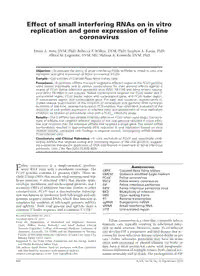
2014 Effect of small interfering RNAs on in vitro replication and gene expression of feline coronavirus PDF
Preview 2014 Effect of small interfering RNAs on in vitro replication and gene expression of feline coronavirus
828 AJVR, Vol 75, No. 9, September 2014 Effect of small interfering RNAs on in vitro replication and gene expression of feline coronavirus Eman A. Anis, DVM, PhD; Rebecca P. Wilkes, DVM, PhD; Stephen A. Kania, PhD; Alfred M. Legendre, DVM, MS; Melissa A. Kennedy, DVM, PhD Objective—To evaluate the ability of small interfering RNAs (siRNAs) to inhibit in vitro viral replication and gene expression of feline coronavirus (FCoV). Sample—Cell cultures of Crandell-Rees feline kidney cells. Procedures—5 synthetic siRNAs that each targeted a different region of the FCoV genome were tested individually and in various combinations for their antiviral effects against 2 strains of FCoV (feline infectious peritonitis virus WSU 79-1146 and feline enteric corona- virus WSU 79-1683) in cell cultures. Tested combinations targeted the FCoV leader and 3′ untranslated region, FCoV leader region and nucleocapsid gene, and FCoV leader region, 3′ untranslated region, and nucleocapsid gene. For each test condition, assessments in- cluded relative quantification of the inhibition of intracellular viral genomic RNA synthesis by means of real-time, reverse-transcription PCR analysis; flow cytometric evaluation of the reduction of viral protein expression in infected cells; and assessment of virus replication inhibition via titration of extracellular virus with a TCID50 infectivity assay. Results—The 5 siRNAs had variable inhibitory effects on FCoV when used singly. Combina- tions of siRNAs that targeted different regions of the viral genome resulted in more effec- tive viral inhibition than did individual siRNAs that targeted a single gene. The tested siRNA combinations resulted in approximately 95% reduction in viral replication (based on virus titration results), compared with findings in negative control, nontargeting siRNA–treated, FCoV-infected cells. Conclusions and Clinical Relevance—In vitro replication of FCoV was specifically inhib- ited by siRNAs that targeted coding and noncoding regions of the viral genome, suggest- ing a potential therapeutic application of RNA interference in treatment of feline infectious peritonitis. (Am J Vet Res 2014;75:828–834) Received December 11, 2013. Accepted April 23, 2014. From the Departments of Biomedical and Diagnostic Sciences (Anis, Wilkes, Kania, Kennedy) and Small Animal Clinical Sciences (Legendre), College of Veterinary Medicine, University of Tennessee, Knoxville, TN 37996; and the Department of Virology, Faculty of Veterinary Medicine, University of Sadat City, Sadat City, Beheira, Egypt 32511 (Anis). Supported by the Winn Feline Foundation and the George Sydney and Phyllis Redmond Miller Trust. The authors thank Dianne Trent for assistance with flow cytometry and Ann Reed for assistance with statistical analyses. Address correspondence to Dr. Anis (
